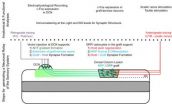(Press-News.org) GAINESVILLE, Fla. – When the ants come marching in, having miles of linked habitats may not be such a good idea after all.
In a classic example of the law of unintended consequences, new University of Florida research suggests that wildlife corridors – strips of natural land created to reconnect habitats separated by agriculture or human activities -- can sometimes encourage the spread of invasive species such as one type of fire ant.
The findings are particularly important in Florida, where invasive species are a vexing problem. The Sunshine State plays host to animals such as Cuban tree frogs, green iguanas and feral hogs. In 2013, the Florida Fish and Wildlife Conservation Commission even sponsored a Burmese python hunting challenge.
The discovery also comes as a team of explorers prepares to embark this fall on its second 1,000-mile expedition to raise support for the Florida Wildlife Corridor. The organization's goal is to create a corridor stretching from Everglades National Park to the Okefenokee National Wildlife Refuge in Georgia.
Could corridors be used by invasive species to spread across conservation lands? Sometimes, according to research by Julian Resasco, who led a study of red imported fire ants while he was a doctoral student in biology at UF. Resasco and his colleagues found that one type of fire ant used wildlife corridors to dominate recently created landscapes. Resasco's paper is published in the August issue of Ecology.
"Although habitat corridors are usually beneficial, they occasionally have negative effects," he said. "Sometimes they can help invasive species spread in exactly the same way they help native species."
The challenge for ecologists is to figure out when invasive species are likely to benefit from corridors. Resasco's results initially surprised the researchers because invasive species are usually talented in their ability to invade new areas -- they shouldn't need corridors to get around. Fire ants turned out to be an exception that proves the rule.
They have two social forms: monogyne and polygyne. Monogyne fire ants fly high in the air to mate and disperse, raining down to create new colonies. Polygyne fire ants, on the other hand, mate low to the ground and sometimes crawl short distances to create new colonies. They don't spread widely and their colonies are dense.
Resasco and his team went to South Carolina to study eight sections of land, each dominated by one of the two social forms. Each section consisted of five patches of regenerating habitat. Each patch was about the size of a football field. Some were connected by a corridor and others were not, allowing the researchers to study the influence of corridors.
The researchers found that corridors significantly increased the abundance of polygyne -- but not monogyne -- fire ants. In polygyne sections, native ant species' diversity was lower in patches connected by corridors than in unconnected patches. That was most likely due to the higher fire ant abundance, according to the study.
Ultimately, Resasco said, whether corridors spread invasive species depends on dispersal ability: "It is not a coincidence that the readily dispersing monogyne form of fire ants doesn't benefit from corridors, whereas the poorly dispersing polygyne form does." For better or worse, poorly dispersing invasive species are exceptional.
More analysis is necessary to determine whether the effects of corridors on invasive species are transient or permanent. In the meantime, Resasco's paper urges land managers to consider animals' traits when making decisions about land corridors. In rare cases, their best intentions could backfire by aiding invasive species.
INFORMATION:
Researchers from North Carolina State University, University of Wisconsin-Madison, Michigan State University, University of Washington and the USDA Agricultural Research Service in Gainesville also worked on the paper.
Resasco is now an NSF Postdoctoral Research Fellow in biology at the University of Colorado at Boulder.
Wildlife corridors sometimes help invasive species spread, UF research finds
2014-08-06
ELSE PRESS RELEASES FROM THIS DATE:
Aggressive behavior increases adolescent drinking, depression doesn't
2014-08-06
Adolescents who behave aggressively are more likely to drink alcohol and in larger quantities than their peers, according to a recent study completed in Finland. Depression and anxiety, on the other hand, were not linked to increased alcohol use. The study investigated the association between psychosocial problems and alcohol use among 4074 Finnish 13- to 18-year-old adolescents. The results were published in Journal of Adolescence.
The results indicate that smoking and attention problems also increase the probability of alcohol use. Furthermore, among girls, early menarche ...
New standards proposed for reporting spinal cord injury experiments
2014-08-06
New Rochelle, NY, August 6, 2014—The difficulty in replicating and directly comparing and confirming the scientific results reported by researchers worldwide who are studying new approaches to treating spinal cord injuries is slowing the translation of important new findings to patient care. A newly proposed reporting standard for spinal cord injury (SCI) experimentation defines the minimum information that is appropriate for modeling an SCI in the research setting, as presented in an article in Journal of Neurotrauma, a peer-reviewed publication from Mary Ann Liebert, ...
Seeing more African Americans in prison increases support for policies that exacerbate inequality
2014-08-06
Informing the public about African Americans' disproportionate incarceration rate may actually bolster support for punitive policies that perpetuate inequality, according to a new study published in Psychological Science, a journal of the Association for Psychological Science.
Stanford University psychology researchers Rebecca Hetey and Jennifer Eberhardt found that White participants who were exposed to higher racial disparities in incarceration rates reported being more afraid of crime and more likely to support the kinds of punitive policies that exacerbate these racial ...
Risks to penguin populations analysed
2014-08-06
A major study of all penguin species suggests the birds are at continuing risk from habitat degradation. Writing in the journal, Conservation Biology, a group of internationally renowned scientists recommends the adoption of measures to mitigate against a range of effects including; food scarcity (where fisheries compete for the same resources), being caught in fishing nets, oil pollution and climate change. This could include the establishment of marine protected areas, although the authors acknowledge this might not always be practical. A number of other ecologically ...
Frontal EEG lateralization as an objective indicator of emotional flexibility was found
2014-08-06
Emotional flexibility has become a widely discussed topic in emotional psychology, clinical psychology, health psychology and other fields. Professor Zhou Renlai and his group from Beijing Key Lab of Applied Experimental Psychology, School of Psychology, Beijing Normal University (BNU) explored whether frontal electroencephalogram (EEG) lateralization can predict emotional flexibility. Frontal EEG activation during different emotion stimuli was measured. They identified the difference of frontal EEG lateralization could predict difference in emotional flexibility. Relative ...
Typhoon Halong opens its eye again for NASA
2014-08-06
When NASA's Aqua satellite passed over Typhoon Halong on its northern journey through the western North Pacific Ocean, it became wide-eyed again after going through eyewall replacement.
Eyewall replacement happens when the thunderstorms that circle the eye of a powerful hurricane are replaced by other thunderstorms. Basically, a new eye begins to develop around the old eye and it usually indicates a weakening trend.
The Moderate Resolution Imaging Spectroradiometer or MODIS instrument aboard Aqua captured a visible image of Halong on August 6 at 04:30 UTC (12:30 a.m. ...
Older adults have morning brains!
2014-08-06
Toronto, Canada – Older adults who are tested at their optimal time of day (the morning), not only perform better on demanding cognitive tasks but also activate the same brain networks responsible for paying attention and suppressing distraction as younger adults, according to Canadian researchers.
The study, published online July 7th in the journal Psychology and Aging (ahead of print publication), has yielded some of the strongest evidence yet that there are noticeable differences in brain function across the day for older adults.
"Time of day really does matter when ...
New hand-held device uses lasers, sound waves for deeper melanoma imaging
2014-08-06
WASHINGTON, Aug. 6, 2014—A new hand-held device that uses lasers and sound waves may change the way doctors treat and diagnose melanoma, according to a team of researchers from Washington University in St. Louis. The instrument, described in a paper published today in The Optical Society's (OSA) journal Optics Letters, is the first that can be used directly on a patient and accurately measure how deep a melanoma tumor extends into the skin, providing valuable information for treatment, diagnosis or prognosis.
Melanoma is the fifth most common cancer type in the United ...
Trapped: Cell-invading piece of virus captured in lab by SLU scientists
2014-08-06
ST. LOUIS – In recent research published in the Journal of Biological Chemistry, Saint Louis University investigators report catching integrase, the part of retroviruses like HIV that is responsible for insertion of the viral DNA into human cell DNA, in the presence of a drug designed to thwart it.
This achievement sets the stage to use x-ray crystallography to develop complete images of HIV that include integrase, which in turn will help scientists develop new treatments for the illness.
Duane Grandgenett, Ph.D., professor at SLU's Institute of Molecular Virology ...
Transplanting neural progenitors to build a neuronal relay across the injured spinal cord
2014-08-06
Cellular transplantation for repair of spinal cord injury is a promising therapeutic strategy that includes the use of a variety of neural and non-neural cells isolated or derived from embryonic and adult tissue as well as embryonic stem cells and induced pluripotent stem cells. In particular, transplants of neural progenitor cells (NPCs) have been shown to limit secondary injury and scar formation and create a permissive environment in the injured spinal cord through the provision of neurotrophic molecules and growth supporting matrices that promote growth of injured host ...





